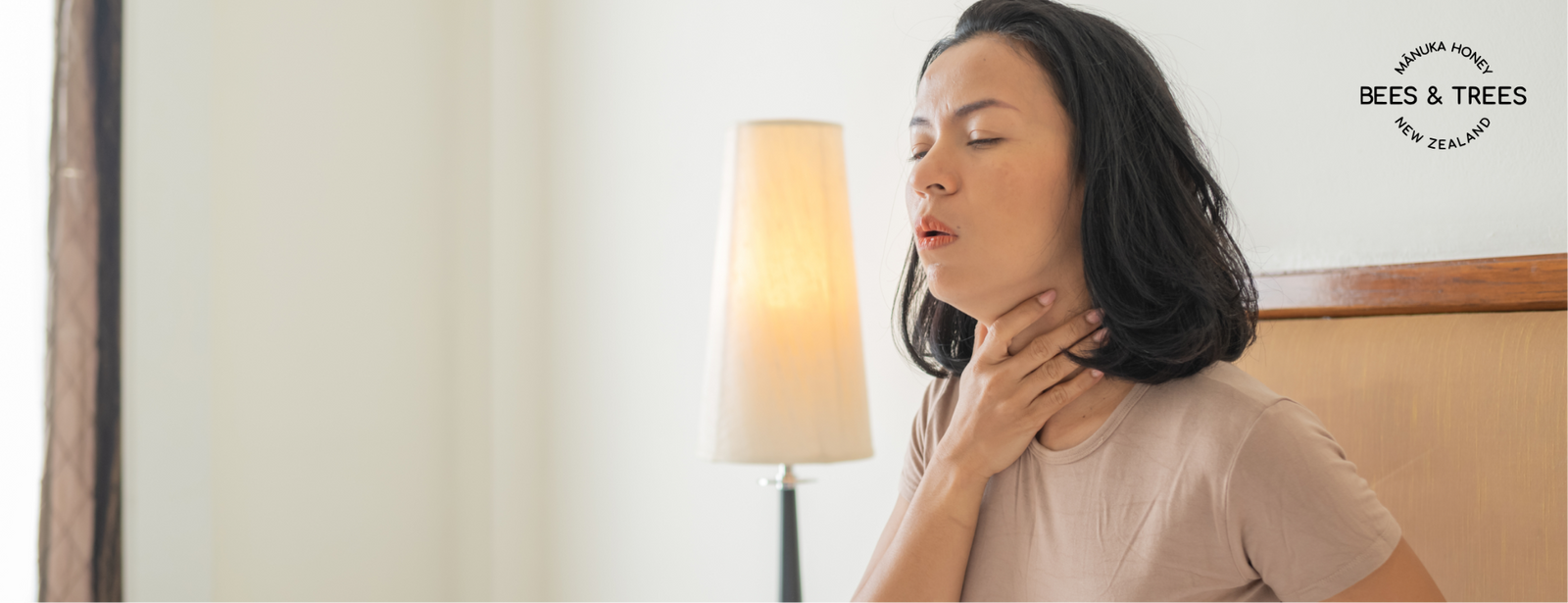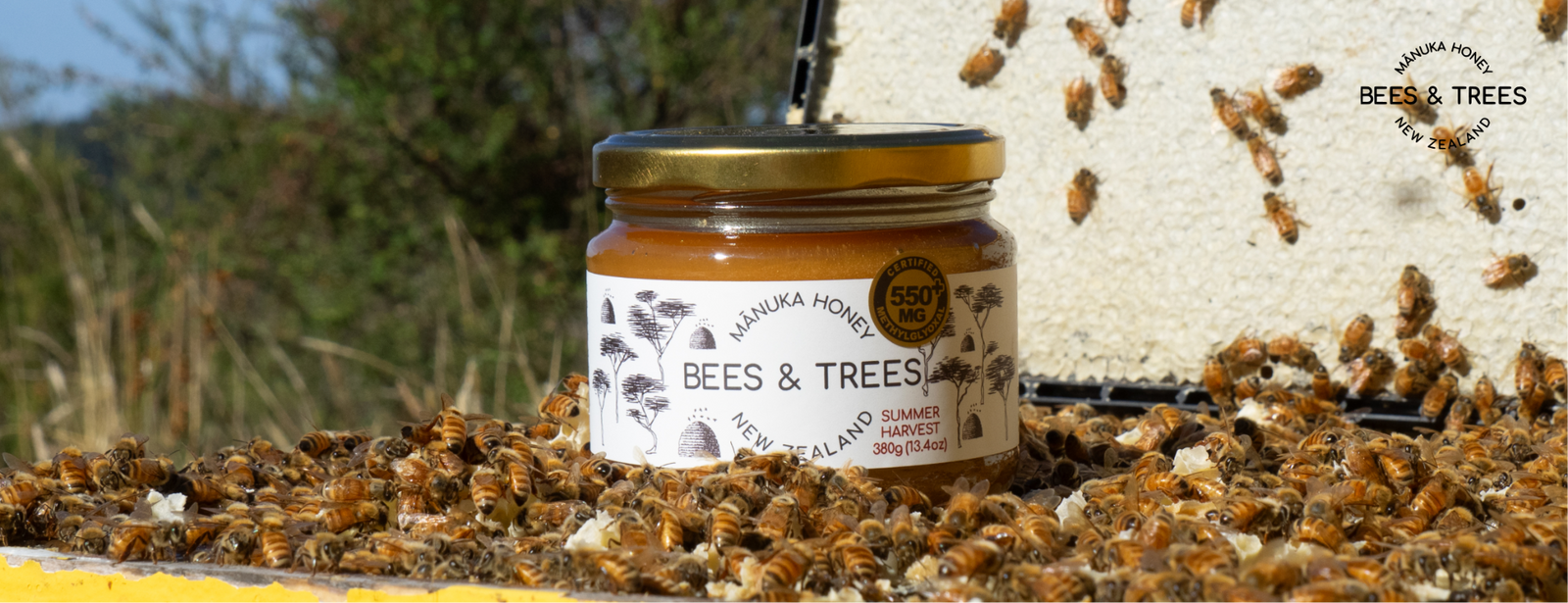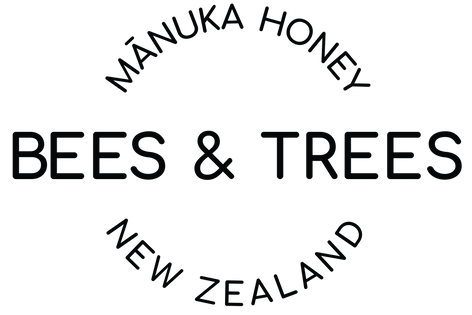MGO (methylglyoxal) is the naturally occurring organic compound that drives Manuka honey’s unique non-peroxide antibacterial activity. The number on the label (e.g., MGO 350+) tells you the concentration in mg/kg. Higher MGO levels are linked in research to stronger antibacterial effects in the lab.
What does MGO mean in Manuka honey?
MGO, short for methylglyoxal, is the naturally occurring organic compound most responsible for Manuka honey’s distinctive antibacterial activity. It forms when dihydroxyacetone (DHA), found in the nectar of Manuka flowers, naturally converts to MGO as the honey matures.
While many honeys contain small amounts of MGO, authentic New Zealand Manuka honey often has concentrations dozens of times higher than other varieties. These elevated levels are what give Manuka honey its “non-peroxide” antibacterial strength, an activity that’s more stable over time than the hydrogen peroxide activity found in most honeys.
When you see MGO 350+ or MGO 550+ on a label, it’s telling you exactly how much methylglyoxal is in that honey, measured in milligrams per kilogram (mg/kg).
As a simple rule, the bigger the number, the greater the potential antibacterial strength, always confirmed by independent lab testing for the specific batch you’re buying.
Research has shown that MGO-rich Manuka honey can inhibit both common and antibiotic-resistant bacteria, including Staphylococcus aureus and Pseudomonas aeruginosa, which is why it has been studied and used in wound care and burn management, often in medical-grade dressings (Kamaratos et. al 2012). Its stability under heat and light makes it particularly suited for these applications.
Beyond wound care, early studies suggest possible benefits in oral health by reducing plaque-forming bacteria (Schmidlin et al 2014), digestive health by inhibiting Helicobacter pylori, a bacterium linked to stomach ulcers (Saad. B et. al), and skin health through activity against acne-causing bacteria.
In short, MGO is one of the defining features that sets Manuka honey apart, the reason it’s so highly prized, and why it has earned a reputation as one of the world’s most valuable and distinctive honeys.
How MGO Forms Naturally: The DHA → MGO Conversion
Source: The story of MGO begins with dihydroxyacetone (DHA), a simple sugar compound found in the nectar of Manuka flowers (Leptospermum scoparium). DHA is not unique to Manuka, but the nectar of this plant contains unusually high levels compared to other floral sources (Adams et al., 2009, Carbohydr Res).
Conversion: Once bees collect the nectar and transform it into honey, the DHA within it begins to convert naturally into methylglyoxal (MGO) through a non-enzymatic chemical reaction. This transformation happens slowly over time and is a key reason why MGO is present in much higher concentrations in Manuka honey than in other honeys.
Influence: How efficiently DHA becomes MGO is influenced by temperature, storage time, and starting DHA levels. Moderate warmth encourages steady conversion, but too much heat breaks down MGO and other beneficial components. Even perfect storage won’t help if the honey was processed at high temperatures or diluted before it reached you.
That’s why both sourcing genuine, raw Manuka honey and storing it correctly are key to ensuring you actually get the MGO level you’re paying for. For maximum benefit, buy from reputable producers who protect the honey’s natural state from hive to jar and store it in cool, stable conditions at home.
This DHA → MGO pathway is characteristic of certain honeys like Manuka and helps explain why freshly harvested honey often has lower MGO levels than the same batch after several months of proper storage.
What Do MGO Numbers Mean? (350+, 550+, 830+)

When you pick up a jar of Manuka honey and see MGO 350+ or MGO 550+ on the label, you’re looking at a measurement of the minimal methylglyoxal content over the shelf life of that jar, expressed in milligrams per kilogram (mg/kg) of honey.
-
MGO 350+ = at least 350 mg of MGO per kilogram
-
MGO 550+ = at least 550 mg of MGO per kilogram
-
MGO 830+ = at least 830 mg of MGO per kilogram
This is not just a marketing number; it’s a chemical analysis result, verified by an independent laboratory. In general, the higher the MGO number, the greater the potential antibacterial activity, as confirmed by laboratory testing (J. Atrott et al)..
How Much MGO Do You Need?
|
MGO (mg/kg) |
What it tells you |
Common uses / Everyday examples |
|
100+ |
Low potency |
Stirring into tea or coffee after cooling, drizzling over yogurt or oatmeal, or sweetening smoothies |
|
350+ |
Moderate potency |
Adding to warm lemon water in the morning, blending it into salad dressings, and spreading it on toast, it is often chosen for daily immune support. |
|
550+ |
High potency |
Often consumed for promoting digestive health, fighting infection during cold / flu season, for skin care and routine wound care applications. |
|
830+ and above |
Very high potency |
Premium-grade honey is sometimes reserved for short-term use and can aid with persistent digestive health issues, advanced wound healing, or provide similar benefits as a lower MGO Manuka in a smaller dose. |
Disclaimer:
The examples above are based on common consumer uses and the traditional enjoyment of Manuka honey. They are not medical advice. While many people have experienced symptom relief and effectively treated common colds, flu, or any other illness, you should always consult a qualified healthcare professional for diagnosis or treatment of health concerns. Honey should not be given to infants under 12 months of age.
Tip: Higher MGO numbers often come with higher prices. Match the potency to your purpose, and always check independent batch test results to confirm the jar contains what’s promised.
Does Higher MGO Mean Stronger Antibacterial Activity?
The short answer is yes. Within the natural range found in authentic Manuka honey, higher MGO concentrations are strongly associated with greater antibacterial activity.
Laboratory studies have consistently demonstrated a correlation between MGO content and the ability to inhibit a wide spectrum of bacteria, including both common and antibiotic-resistant strains such as Staphylococcus aureus and Escherichia coli (J. Atrott et al).
That said, more is not always better for every situation. A jar with MGO 830+ may have exceptional antibacterial potential, but it’s also considerably more expensive and not necessary for everyday enjoyment.
Many consumers find moderate-to-high potencies, such as MGO 350+ or 550+, provide a good balance of strength, versatility, and value.
Practical takeaway: If you’re choosing Manuka honey for general wellness or culinary use, you don’t need the very highest MGO number. But if your priority is maximum antibacterial activity, and cost isn’t a concern, the higher grades may be worth considering, always backed by independent lab verification for authenticity and potency.
MGO vs Hydrogen Peroxide Activity in Regular Honey
Most honeys have natural antibacterial properties, but in regular honey, this activity comes mainly from hydrogen peroxide, a compound formed by the enzyme glucose oxidase. While effective, hydrogen peroxide is unstable and can break down quickly when exposed to heat, light, or certain enzymes, reducing the honey’s antibacterial potential over time.
“Manuka honey differs from other types because its main antibacterial power comes from MGO, which remains more stable than hydrogen peroxide under typical storage and handling. However, peer-reviewed studies show that prolonged exposure to high heat (e.g., sustained 90 °C/194 °F ) can significantly reduce MGO levels, with reductions of over 50% after two hours, emphasizing the need for moderate heat exposure. (Yoji Kato et al.)
This stability is one of the reasons Manuka honey, and specifically its MGO content, has been studied for clinical uses like wound dressings and sterile medical products. It’s also why MGO ratings are a more reliable indicator of antibacterial strength than simply assuming “all honeys are the same.”
Key takeaway: Hydrogen peroxide activity can fade, but MGO provides a more enduring antibacterial effect, which is why the number on your Manuka honey jar matters so much.
Does Hot Tea or Cooking Destroy MGO?
It’s a common question: If I stir Manuka honey into hot tea, will it lose its benefits?
The short answer is that temperature matters, but not entirely. MGO is relatively stable at moderate heat, meaning it can withstand the warm water you'd typically drink. However, prolonged exposure to high heat (such as boiling water or sustained cooking temperatures above ~60–70°C / 140–158°F) can begin to break down MGO and other beneficial compounds in honey (Yoji Kato et al.).
Best practice:
-
If you want to mix Manuka honey into tea, let the water cool for a few minutes after boiling before adding it.
-
Avoid adding honey to food during high-heat cooking or baking if preserving MGO levels is a priority.
-
Store Manuka honey at ambient temperature (in the pantry or on the kitchen counter), it does not need to be refrigerated.
Tip: Adding Manuka honey to boiling water, add it at a temp you are comfortable drinking your tea, coffee, or immunity-supporting beverage.
How to Read an MGO Lab Report (Batch Certificates Explained)
If you’re buying authentic Manuka honey, the MGO number on the label should be backed by independent laboratory testing. A few brands actually publish the batch test results on their website or via a QR code or batch number on the jar.
Batch testing means that the exact production lot your jar came from was sampled and analysed, so the numbers on the certificate directly reflect the composition and quality of the honey you’re holding.
Key things to look for:
In New Zealand, the Ministry for Primary Industries (MPI) sets a legal definition for Manuka honey. To be exported as “monofloral” or “multifloral” Manuka, a honey must pass tests for four specific plant-derived chemical markers and one DNA marker from Manuka pollen, all performed in MPI-recognised independent labs (MPI.govt.nz).
-
The label should either say Manuka honey or Monofloral Manuka honey. Avoid the words “Manuka honey blend” or “Multi-floral Manuka honey”
-
MGO (mg/kg): This is the actual methylglyoxal level measured in milligrams per kilogram of honey.
-
DHA: The precursor to MGO, measured to confirm natural origin and assess potential for further MGO development during storage.
-
HMF (Hydroxymethylfurfural): A freshness marker, high levels can indicate overheating or long storage times, which may reduce quality.
Why verification matters
-
Protects against mislabelling: ensures the MGO figure on the label matches what’s in the jar.
-
Guards against adulteration: verifies the honey hasn’t been diluted or blended with non-Manuka honeys.
-
Builds trust: lets you compare potency across brands with confidence.
Look for a batch number or QR code on the jar. This lets you access the actual lab report for your honey, so you can see exactly what was tested and verified for the product you’re holding.
Bottom line: A high MGO number is only meaningful if it’s backed by trustworthy, verifiable testing. Always check for a batch number and see if the brand provides publicly accessible lab results for the jar you’re buying.
Frequently Asked Questions About MGO in Manuka Honey

1. What does the MGO number on Manuka honey mean?
The MGO number shows how much methylglyoxal is in the honey, measured in milligrams per kilogram (mg/kg). For example, MGO 350+ means there are at least 350 mg of methylglyoxal in every kilogram of honey. Higher numbers generally mean stronger antibacterial potential, but you should choose a potency that matches your intended use and budget.
2. Is higher MGO always better?
Not necessarily. While higher MGO values (like 830+) indicate greater antibacterial activity in lab tests, these strengths are not needed for most everyday uses. Many people choose MGO 350+ to 550+ as a balance between potency and price. Very high MGO grades are typically reserved for specialist or medical-grade applications. For deeper insight into how Manuka honey’s rare bioactive profile drives its price, check out our article Why Manuka honey commands a premium price.
3. How is MGO measured in Manuka honey?
MGO is measured using high-performance liquid chromatography (HPLC), a precise laboratory method that separates and quantifies methylglyoxal in honey. Reputable brands use independent, accredited laboratories and provide batch certificates so you can verify the MGO content of the exact jar you’ve purchased.
4. How does MGO compare to UMF?
MGO measures the amount of methylglyoxal, the primary indicator of antibacterial strength, and the honey’s purity. UMF (Unique Manuka Factor) is a grading system that directly correlates with the lab-tested MGO value.
5. Can I add Manuka honey to hot tea without destroying the MGO?
Yes, to an extent. MGO is heat-stable at moderate temperatures, so adding it to warm drinks is fine. However, prolonged exposure to boiling water or high cooking temperatures can reduce MGO levels. Let your tea cool for a few minutes before stirring in your honey if you want to preserve maximum potency.
6. Does the MGO level change over time?
Yes. Fresh Manuka honey often contains more DHA (the precursor to MGO) and less MGO. Over time, especially when stored correctly, DHA naturally converts to MGO. However, poor storage conditions (excessive heat, light, or moisture) can degrade MGO, so keep your jar at ambient temperatures with the lid sealed.
7. What MGO level is used in medical-grade wound dressings?
Medical-grade Manuka honey wound dressings often contain MGO 500+ to 830+ or higher. These honeys are sterilised and used under medical supervision to help manage bacterial growth in wounds.
8. How can I check if my jar’s MGO rating is real?
Look for a batch number or QR code on the label. Reputable brands let you enter this online or scan it to view the independent lab report for your jar. This confirms the tested MGO level and helps ensure you’re buying genuine, unadulterated Manuka honey.
9. Does Manuka honey with lower MGO still have benefits?
Yes. Even at lower levels (e.g., MGO 83+), Manuka honey still offers natural sweetness. Most of the science and medical research focuses on Manuka honey with MGO levels of at least 250 or higher. That is generally the level that is considered to have a wellness or healing benefit when consumed.
10. Is MGO in Manuka honey safe?
For most people, yes, but honey should never be given to infants under 12 months old due to the risk of infant botulism. People with diabetes, bee product allergies, or other specific health concerns should consult a healthcare professional before regular use.
Conclusion

MGO is the source of Manuka honey’s unique antibacterial strength. Understanding what the number on your jar means, and verifying it through independent batch testing, ensures you’re getting the quality, authenticity, and potency you expect. Whether you enjoy it daily in warm drinks or reserve higher grades for special uses, the right MGO level is the key to unlocking the best of what Manuka honey can offer.
Discover Manuka Honey You Can Trust: Bees & Trees
If you want Manuka honey with clearly labelled MGO levels and independent lab results for every batch, look no further than Bees & Trees. This small, New Zealand-based producer is dedicated to keeping honey pure, unadulterated, and exactly as nature intended, straight from their hives to your jar.
Every batch is tested in an accredited lab, and the results are made public, so you know the MGO content you’re paying for is the MGO content you’re actually getting. From raw flavour to verified potency, Bees & Trees delivers Manuka honey you can enjoy with complete confidence.
Explore Bees & Trees Manuka Honey →
Sources
Peer-reviewed:
-
Adams CJ, Boult CH, Deadman BJ, Farr JM, Grainger MN, Manley-Harris M, Molan PC. Isolation by HPLC and characterisation of the bioactive fraction of New Zealand Manuka (Leptospermum scoparium) honey. Carbohydrate Research. 2009;344(10): 1524–1531.
-
Adams CJ, Manley-Harris M, Molan PC. The origin of methylglyoxal in New Zealand Manuka (Leptospermum scoparium) honey. Food Chemistry. 2008;106(2): 656–663.
-
Kato Y, et al. Heat-induced degradation of MGO in Manuka honey. PLOS ONE. 2016.





